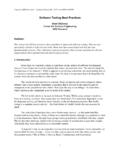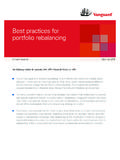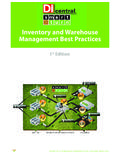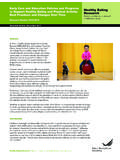Transcription of Guidelines and Best Practices for Safe Handling of ...
1 Guidelines and best Practices for Safe Handling of nanomaterials in research laboratories and Industries Compiled for Nano Mission, DST, Govt of India (with inputs from Nanoregulatory Task Force). By Centre for Knowledge Management of Nanoscience & Technology (A Project of ARCI, Department of Science & Technology, Govt. of India). 12-5-32/8, Vijayapuri Colony, Tarnaka, Secunderabad-500 017, , India Telephone: +91 40 2700 7032, 2700 0251, Telefax: +91 40 2700 7031. E-mail: Website: About the Report Realising the emerging importance of safe Handling of nanomaterials , the Nano Mission of Govt. of India constituted a Nanoregulatory Task Force consisting of eminent experts to bring out a comprehensive document on Guidelines and best Practices for Safe Handling of nanomaterials in research laboratories and Industries . Under the able guidance of Nano Mission and Nanoregulatory Task Force, CKMNT has brought out this comprehensive document based on published reports by regulatory bodies like ISO, OECD, NIOSH, OSHA and other reports available in public domain.
2 ACKNOWLEDGEMENTS. CKMNT acknowledges all the task force members, who directly or indirectly have extended their support by providing substantive inputs for the preparation of this Guidelines for safe Handling of nanomaterials , in particular we would like to thank the following taskforce members. Dr. Baldev Raj, President, Indian National Academy of Engineering and JC Bose Fellow, DST. India, President- research , PSG Institutes Dr. G. Sundararajan, Director, ARCI. Prof. Shantikumar V. Nair, Amrita Institute of Medical Sciences Dr. KC Gupta, Director, IITR. Prof. Budhani, Director, NPL. Dr. , Scientist G', DBT. Dr. Ramaraju, Senior Director and Head, Nanotechnology Initiative Division, DIT. Dr. Vijay Kumar, Scientist F', ICMR. Dr. Geeta Jotwani, Scientist D', ICMR. Dr. N. Vigneshwaran, Scientist (SS), Central Institute for research on Cotton Technology Dr.
3 Sujata Khaparde, A. D. (RE), MoEF. Dr. G. Narayana Raju, and L. C. R, Ministry of Law and Justice Dr. Joshi, Associate Director, ARCI. Shri Anil Relia, Director, NABL. Shri. Deepak Jain, Member Secretary, MTD. Dr. Praveer Asthana, Head (AI) and Mission Director, Nano Mission, DST. Table of Contents S. No. Topic Page No. 1. Introduction 1. 2 Identifying hazards 2. 3 Pathways and common tasks that could result in exposure 5. Exposure control strategies a. Engineering controls 6. 4 b. Administrative (procedural) controls c. Personal protective equipments (PPE). d. Waste disposal best Practices to be followed while Handling nanoparticles a. Locating emergency equipment 9. 5 b. Hygiene c. Labeling and signage d. Cleaning procedures and spill best Practices and adequate approaches regarding making and 6 Handling of nanopowders and use of products relating to food and 11.
4 Healthcare Safety Practices a. Transporting 13. b. Buddy system 7. c. Explosion safety d. Access control e. Dry materials 8 Product stewardship 14. References 15. Abbreviations 17. Glossary 18. Guidelines and best Practices for Safe Handling of nanomaterials in research laboratories and Industries 1. Introduction Engineered nanomaterials , as for example, nanospheres, nanotubes, nanowires and nanosheets, possess a unique combination of physical, chemical, biological, mechanical, electrical and thermal properties. This makes them promising candidates for a variety of structural and functional applications. However, due to their extremely small dimensions, large surface area and high reactivity, they have the potential ability to penetrate living cells quite readily. As a result, their unique nano-features may also make them potentially hazardous for human health and environmental safety.
5 Therefore, intense research activity is being undertaken in various R&D. institutions, universities and industries across the world to evaluate their toxicity and critical exposure levels. Currently, evidence regarding the toxic effects of nanomaterials on humans in the scientific and technical literature is insufficient and consequently their risk remains unknown. Under the umbrella of the Government of India's Nano Mission, as well as by virtue of substantial research funding from other sources, a large number of researchers from national laboratories , universities and industries are pursuing R&D work on various projects involving ceramic nanoparticles, carbon nanotubes, nanowires, nanostructured alloys etc. There is every likelihood that persons associated with these projects, as well as their colleagues, could be inadvertently exposed to the various nanomaterials being investigated in their laboratories , which may cause health related problems if proper precautions are not taken in Handling them.
6 nanomaterials -related safety has been a growing concern among the research community and the regulatory agencies in India. In view of this, the Nano Mission has decided to formulate a regulatory framework to address the issues of Environment, Health and Safety (EH&S) impact and risk from nanomaterials and nano- related products. Recently, a task force has been set up under the chairmanship of Dr. Baldev Raj, former director, Indira Gandhi Center for Atomic research (IGCAR) to lay a roadmap to regulatory framework for nanotechnology in India. Based on the recommendations of the above task force, the Centre for Knowledge Management of Nanoscience and Technology (CKMNT), partially funded by the nano mission and the International Advanced research Centre for Powder Metallurgy & New Materials (ARCI), has taken up a new initiative to prepare Guidelines for scientists and technocrats working in R&D laboratories to implement best Practices for safe Handling of nanomaterials at their work places.
7 The following Guidelines address the exposure risks and prudent control measures to be followed while working with nanomaterials to reduce risks. It is recommended that the researchers planning to work with nanomaterials must implement a combination of engineering controls, work Practices , and personal protective equipment to minimize potential exposure to themselves and others. It is hoped that this document would serve as an interim reference until a comprehensive regulatory framework that covers the potential risks and safe Handling procedures of nanomaterials is formulated. This will ensure that nanomaterials are produced, handled and used in a safe and sustainable way that is essential to exploit their societal benefits. Over the years, regulators and industry have put in place systematic processes for identifying, managing and reducing potential environmental, safety and health risks of chemicals across their entire life cycle.
8 As nanomaterials are chemical substances, this approach also applies to them. The EU's comprehensive regulatory framework, including REACH, can be implemented and where necessary adapted to effectively regulate nanomaterials . Looking beyond the potential technical risks associated with nanomaterials , there is actually only scarce information available about the impact of nanomaterials on non-human species, on ecosystems or the global environment. Even within established questions of toxicology, still the fact is unclear about how different nanoparticles exactly interact within the human body or with the environment, which means that more data is needed. 1. Guidelines and best Practices for Safe Handling of nanomaterials in research laboratories and Industries With a view of providing basic Guidelines to the researchers on safe Handling of nanomaterials , CKMNT has compiled this document based on published reports by regulatory bodies like ISO, OECD, NIOSH, OSHA available with public domain and experience, of Indian experts.
9 2. Identifying hazards The identification of hazards is the first step in determining risk and exposure. This step involves identifying chemicals or nanomaterials , and their associated processes that pose toxic, physical ( high levels of noise, high pressures and vacuum, strong electromagnetic flux, etc.) and physicochemical hazards. When assessing the risks associated with nanomaterials , special care should be taken to identify the specific effect of surface chemistry, shape, size and morphology on toxicity caused to various organs. The following primary hazard categories may be considered when assessing risk associated with nanomaterials . Surface charge The most interesting physicochemical feature of nanoparticle relating to cytotoxicity is the surface charge, with toxicity increasing in the following way: neutral < anionic < cationic.
10 [Ref: Angeles Villanueva et al., The influence of surface functionalization on the enhanced internalization of magnetic nanoparticles in cancer cells , Nanotechnology 20 (2009) 115103]. Surface chemistry Surface chemistry of nanoparticles may have a role in the generation of free radicals, which influences the overall surface reactivity and toxicity of ingested particles. Particle shape Studies have clearly established that exposure to fibrous particles like asbestos increases the risk of fibrosis and cancer. Similarly, the tubular structure of carbon nanotubes is believed to cause inflammation and lesions in lungs. Particle size Nanoparticles have a greater chance of depositing in the lungs than micro-sized particles, and therefore have the potential to cause damage by acting directly at the site of deposition by translocating to other organs or by being absorbed through the blood.






